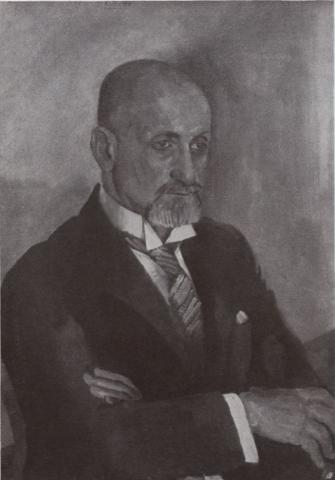The dentist Heinrich Rieger lived with his wife Berta and three children in an apartment in Vienna’s 7th district at Mariahilferstraße 124, where he also had his dental practice. From the 1920s onwards, he worked there together with his son-in-law Fritz Ticho, daughter-in-law Rosa and son Robert. His success as a dentist formed the economic basis for Rieger's contemporary art collection. Around 800 works by over 270 artists adorned his home and practice as well as the summer house with its sculpture garden in Gablitz, Lower Austria. The collection focused on several oil paintings and around 140 works by Egon Schiele, who - like Josef Dobrowski and Luigi Kasimir - paid Rieger for dental treatments with works of art. Ludwig Jungnickel, Ferdinand Kitt, Alfred Hawel, Egon Schiele, Max Oppenheimer, Josef Dobrowsky and Franz Wiegele painted portraits of the art lover, and Gustinus Ambrosi created a sculpture of him. He was a generous lender and published works from his collection in various magazines. In 1928, Rieger attempted to sell the public collection, which was bursting at the seams. However, neither the City of Vienna nor the Republic of Austria showed any interest. Following the presentation of his collection in the 1935 autumn exhibition at the Künstlerhaus, the exhibition Exposition d'Art Autrichien at the Musée du Jeu de Paume des Tuileries in Paris in 1937 was to bring the international recognition of his collecting activities to a climax.
The annexation of Austria to the German Reich meant not only the Nazi persecution of the Jewish Rieger family, but also the destruction of Rieger's lifework. After losing the license to practice medicine due to the Fourth Ordinance to the Reich Citizenship Act of July 1938, the couple moved to Gablitz in October 1938. One month later, Rieger had to transfer the villa to the municipality by means of an annuity for life contract, clear the house and reduce the size of the art collection. In the fall of 1938, Robert and Rosa Rieger were able to flee to the USA with their daughter Eva, while his son-in-law Fritz Ticho and his daughter Tanna managed to escape to Palestine. After the Nazi authorities ordered all Jews from the provinces to move to Vienna in the fall of 1939, Heinrich and Berta Rieger were forced to change their accommodation several times and completely liquidate their art collection. When and to whom Rieger sold his collection can be only partially traced.
Works went to various residents in Gablitz, more than 20 of the most important paintings were acquired by the art dealer Friedrich Welz and his Galerie Würthle, which he had "aryanized", or were sold to art trades like Benno Moser, Margarethe Grachegg and the Galerie Zinckgraf. The largest part of the collection was acquired in 1941 by Luigi Kasimir, the "aryanizer" of the gallery Halm und Goldmann. The Municipal Collections of the City of Vienna bought a Klimt study for the university fresco Medicine at the Dorotheum. In June 1942, Heinrich and Berta Rieger moved to the nursing home of the Jewish Community in Zirkusgasse, in Vienna's 2nd district, Leopoldstadt, before being sent to the Malzgasse 7 collective camp in September 1942 and deported shortly afterwards on the 42nd transport to the Theresienstadt ghetto. Heinrich Rieger died there on 17 October 1942, Berta Rieger was deported from Theresienstadt to Auschwitz on 16 May 1944 and presumably murdered in the gas chambers immediately after her arrival.
After 1945, Robert Rieger's legal representative reported the loss of the art collection to the Federal Monuments Office. In June 1946, the People's Court of Vienna sentenced Luigi Kasimir to 18 months in prison for his illegal membership in the NSDAP. Affected by sanctions against National Socialists, Viennese authorities (Housing Office) opened Kasimir's apartment and studio (once "aryanized" from Elsa Gall), where they seized 800 works of art. These were transferred to the depot of the Municipal Collections, and the Vienna Federal Monuments Office assigned 187 works of art to the former Rieger Collection. With the exception of four paintings, which the museum retained as "compensation for transportation and storage costs", the works were subsequently transferred by Robert Rieger to New York and by Tanna Ticho to Tel Aviv. In 2002, the Vienna Restitution Commission decided on the restitution of these four paintings by Gottlieb T. Kempf, Robin C. Andersen, Josef Dobrowsky and Sergius Pauser, followed by the return of the aforementioned Klimt drawing from the Wien Museum in 2006. Twelve works of art had also been seized from Friedrich Welz by the American Allies and restituted in May 1948. However, Welz was also in possession of other paintings that belonged to Heinrich Rieger, which he hid from the authorities or which were later handed over to him without examination by the US authorities.
In 1949, he sold the Schiele paintings Meadow Landscape with Houses to the Österreichische Galerie Belvedere and in 1958 Harbour of Trieste to the Neue Galerie in Graz. Both paintings were returned to Heinrich Rieger's legal successors in 2004 and 2006, in accordance with the Austrian Art Restitution Act and the Styrian Provincial Art Restitution Act.

